Demographics of Afghanistan
| Demographics of Afghanistan | |
|---|---|
|
| |
| Population | 32,564,342[1] |
| Growth rate | 2.32% (2015) |
| Birth rate | 38.57 births/1,000 population (2015) |
| Death rate | 13.89 deaths/1,000 population (2015) |
| Life expectancy | c. 60 years (2011) [2] |
| • male | 59 years |
| • female | 61 years |
| Fertility rate | 5.33 children born/woman (2015) |
| Infant mortality rate | 66.3 deaths/1,000 live births[3] |
| Age structure | |
| 0–14 years | 42.3% (male 6,464,070/female 6,149,468) |
| 15–64 years | 55.3% (male 8,460,486/female 8,031,968) |
| 65 and over | 2.4% (male 349,349/female 380,051) |
| Sex ratio | |
| At birth | 1.05 male/female |
| Under 15 | 1.03 male/female |
| 15–64 years | 1.04 male/female |
| 65 and over | 0.87 male/female |
| Nationality | |
| Nationality | noun: Afghan(s) |
| Major ethnic | Pashtun, Tajik, Hazara, Uzbek, and others |
| Language | |
| Official | Pashto and Dari [4] |
| Spoken | Pashto, Dari, Uzbeki, Turkmeni, and other |
The population of Afghanistan is around 32 million as of 2015,[1] which includes the 2.7 million Afghans citizens that are residing temporarily in Pakistan and Iran.[5] The nation is composed of a multi-ethnic and multilingual society, reflecting its location astride historic trade and invasion routes between Central Asia, Southern Asia, and Western Asia. The largest ethnic group among Afghanistan's population is the Pashtuns, followed by Tajiks, Hazaras, Uzbeks, Aimaks, Turkmen, Baloch and others.[1][6]
As of 2013 46% of Afghanistan's population are under 15 years of age and 74% of the population live in rural areas.[7] The average woman gave birth to five children during her life and 6.8% of all babies died in child-birth or infancy.[8] Life expectancy in 2013 was 60 years and only .1% of the population between ages 15 and 49 had HIV.[9]
Pashto and Dari (Afghan Persian) are both the official languages of the country.[4] Dari is mostly spoken in the Tajik- and Hazara-dominated areas, while Pashto is spoken mainly in the Pashtun tribal areas south of the Hindu Kush mountains. Uzbek and Turkmen are spoken in parts of the north. Smaller groups in various parts of the country speak about 30 other languages.[1] Multilingualism is common throughout the country, especially in the major cities. Afghan Persian is the predominate language spoken in urban areas but language is not necessarily an indicator of an individuals ethnic or group identity since Pashto and Dari are both spoken by nearly all of the country's ethnic groups (Turkmen and Uzbeks generally constituting an exception to this rule).[10]
Islam is the religion of more than 99% of Afghanistan's citizens. An estimated 80–90% of the population practice Sunni Islam and belong to the Hanafi Islamic law school, while 7–19% are Shia;[1][11][12] the majority of the Shia follow the Twelver branch, with smaller numbers of Ismailis. The remaining 1% or less practice other religions such as Sikhism and Hinduism. Excluding urban populations in the principal cities, most Afghans are organized into tribal and other kinship-based groups, who follow their own traditional customs, for instance Pashtunwali. The majority of the country's population lives in rural areas and is involved in agricultural activities.
Population statistics
As of 2013, the total population of Afghanistan is around 32,564,342,[1] which includes the 2.7 million Afghan citizens that are living in Pakistan and Iran.[5] In 2009, a nationwide survey conducted by the Afghan Central Statistics Organization (CSO) estimated that the total number of Afghans living inside Afghanistan was about 24.5 million and by 2011 it reached 26 million. Of this, 5.7 million people (some 22%) were reported to be living in urban areas and the rest in rural or countryside.[5]
After the 1978 Marxist coup, hundreds of Afghans began leaving the country as refugees - most of these were related to the ousted president Mohammad Daoud Khan. In 1979, the population was reported to be about 15.5 million.[13][14] From the start of the Soviet invasion on 24 December 1979 until the end of 1983, some 4 million people, a quarter of the population, left the country to take shelter in neighboring northwestern Pakistan and eastern Iran. The Statistical Yearbook published in 1983 by the Babrak Karmal government claimed a total population of 15.96 million for 1981–82.[15] Some suggest that between 600,000 and 2 million Afghans were killed during the various 1979–2001 wars, majority of them during the Soviet war in the 1980s.[16] According to the Population Reference Bureau, the Afghan population is estimated to increase to 82 million by 2050.[17]
Urban areas are experiencing rapid population growth since the Karzai administration began in late 2001, which is mainly due to the return of over 5 million expats. The only city in Afghanistan with over a million residents is its capital, Kabul. The other largest cities in the country are shown in the chart below.
| | |||||||||
|---|---|---|---|---|---|---|---|---|---|
| Rank | Name | Province | Pop. | ||||||
 Kabul 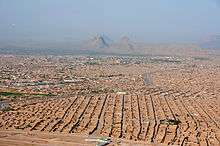 Kandahar |
1 | Kabul | Kabul Province | 3,289,000 | 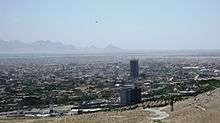 Herat 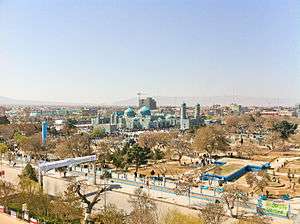 Mazar-i-Sharif | ||||
| 2 | Kandahar | Kandahar Province | 491,500 | ||||||
| 3 | Herat | Herat Province | 436,300 | ||||||
| 4 | Mazar-i-Sharif | Balkh Province | 368,100 | ||||||
| 5 | Kunduz | Kunduz Province | 304,600 | ||||||
| 6 | Taloqan | Takhar Province | 219,000 | ||||||
| 7 | Jalalabad | Nangarhar Province | 206,500 | ||||||
| 8 | Puli Khumri | Baghlan Province | 203,600 | ||||||
| 9 | Charikar | Parwan Province | 171,200 | ||||||
| 10 | Sheberghan | Jowzjan Province | 161,700 | ||||||
Age structure
0–14 years: 42.3% (male 6,464,070/female 6,149,468)
15–64 years: 55.3% (male 8,460,486/female 8,031,968)
65 years and over: 2.4% (male 349,349/female 380,051) (2011 est.)
Population growth rate
In 1979, the population was reported to be about 15.5 million.[19]
2.32% (2015 est.)[1]
country comparison to the world: 39
Urbanization

urbanization population: 24% of the total population (2008)
rate of urbanization: 5.4% annual rate of change (2005–10 est.)
Sex ratio
at birth: 1.05 male(s)/female
under 15 years: 1.05 male(s)/female
15–64 years: 1.05 male(s)/female
65 years and over: 0.93 male(s)/female
total population: 1.05 male(s)/female (2009 est.)
Vital statistics
UN estimates[20]
| Period | Live births per year | Deaths per year | Natural change per year | CBR1 | CDR1 | NC1 | TFR1 | IMR1 |
|---|---|---|---|---|---|---|---|---|
| 1950–1955 | 450 000 | 313 000 | 136 000 | 52.9 | 36.9 | 16.0 | 7.70 | 275.0 |
| 1955–1960 | 489 000 | 322 000 | 168 000 | 52.9 | 34.8 | 18.1 | 7.70 | 260.6 |
| 1960–1965 | 538 000 | 333 000 | 205 000 | 52.8 | 32.7 | 20.2 | 7.70 | 245.4 |
| 1965–1970 | 596 000 | 343 000 | 253 000 | 52.6 | 30.3 | 22.4 | 7.70 | 228.1 |
| 1970–1975 | 664 000 | 356 000 | 308 000 | 52.1 | 27.9 | 24.2 | 7.70 | 211.4 |
| 1975–1980 | 713 000 | 354 000 | 360 000 | 51.5 | 25.6 | 26.0 | 7.70 | 194.5 |
| 1980–1985 | 694 000 | 323 000 | 372 000 | 51.8 | 24.1 | 27.7 | 7.80 | 182.8 |
| 1985–1990 | 669 000 | 291 000 | 378 000 | 52.2 | 22.7 | 29.5 | 7.90 | 171.9 |
| 1990–1995 | 863 000 | 352 000 | 512 000 | 52.6 | 21.4 | 31.2 | 8.00 | 161.8 |
| 1995–2000 | 1 118 000 | 429 000 | 688 000 | 52.4 | 20.1 | 32.3 | 8.00 | 152.3 |
| 2000–2005 | 1 221 000 | 463 000 | 759 000 | 48.4 | 18.3 | 30.1 | 7.35 | 143.7 |
| 2005–2010 | 1 332 000 | 496 000 | 836 000 | 45.1 | 16.8 | 28.3 | 6.62 | 136.0 |
| 1 CBR = crude birth rate (per 1000); CDR = crude death rate (per 1000); NC = natural change (per 1000); TFR = total fertility rate (number of children per woman); IMR = infant mortality rate per 1000 births | ||||||||
Fertility and Births
Total Fertility Rate (TFR) and Crude Birth Rate (CBR):[21]
| Year | CBR (Total) | TFR (Total) | CBR (Urban) | TFR (Urban) | CBR (Rural) | TFR (Rural) |
|---|---|---|---|---|---|---|
| 2010 | 35,6 | 5,1 | 34,7 | 4,5 | 35,9 | 5,2 |
| 2015 | 36,8 | 5,3 | 35,8 | 4,8 | 37,1 | 5,4 |
Structure of the population[22]
Structure of the population (2012.01.07) (Data refer to the settled population based on the 1979 Population Census and the latest household prelisting. The refugees of Afghanistan in Iran, Pakistan, and an estimated 1.5 million nomads, are not included):
| Population pyramid 2012 | ||||||||
|---|---|---|---|---|---|---|---|---|
| Age Group | Male | Female | Total | % | ||||
| Total | 13 044 400 | 12 455 700 | 25 500 100 | 100 | ||||
| 0–4 | 2 422 244 | 2 556 304 | 4 978 548 | 19.52 | ||||
| 5–9 | 1 941 363 | 1 880 407 | 3 821 770 | 14.99 | ||||
| 10–14 | 1 556 158 | 1 401 695 | 2 957 853 | 11.60 | ||||
| 15–19 | 1 276 563 | 1 140 810 | 2 417 373 | 9.48 | ||||
| 20–24 | 1 059 939 | 1 009 807 | 2 069 746 | 8.12 | ||||
| 25–29 | 843 967 | 864 738 | 1 708 705 | 6.70 | ||||
| 30–34 | 678 577 | 745 534 | 1 424 111 | 5.58 | ||||
| 35–39 | 598 045 | 652 326 | 1 250 371 | 4.90 | ||||
| 40–44 | 546 102 | 533 524 | 1 079 626 | 4.23 | ||||
| 45–49 | 495 190 | 440 789 | 935 979 | 3.67 | ||||
| 50–54 | 435 143 | 354 633 | 789 776 | 3.10 | ||||
| 55–59 | 360 394 | 275 468 | 635 862 | 2.49 | ||||
| 60–64 | 281 627 | 209 152 | 490 779 | 1.92 | ||||
| 65–69 | 204 376 | 150 137 | 354 513 | 1.39 | ||||
| 70–74 | 141 729 | 102 048 | 243 777 | 0.96 | ||||
| 75–79 | 91 164 | 64 658 | 155 822 | 0.61 | ||||
| 80–84 | 55 446 | 38 699 | 94 145 | 0.37 | ||||
| 85+ | 56 373 | 34 971 | 91 344 | 0.36 | ||||
| Age group | Male | Female | Total | Percent |
|---|---|---|---|---|
| 0-14 | 5 919 765 | 5 838 406 | 11 758 171 | 46.11 |
| 15–64 | 6 575 547 | 6 226 781 | 12 802 328 | 50.21 |
| 65+ | 549 088 | 390 513 | 939 601 | 3.68 |
Life expectancy at birth
total population: 60+ years (2013)[2][23]
country comparison to the world: 214
male: 59 years (2013)[23]
female: 61 years (2013)[23]
Development and health indicators

Literacy
- Definition: People over the age of 15 that can read and write
- Total population: 31% (2005 est.)[24]
- Male: 43% (2005)
- Female: 20% (2005)
School life expectancy (primary to tertiary education)
total: 8 years
male: 11 years
female: 4 years (2004)
HIV/AIDS – adult prevalence rate
About 0% (2011 est.)
In 2008, health officials in Afghanistan reported 504[25] cases of people living with HIV but by the end of 2012 the numbers reached 1,327. The nation's healthy ministry stated that most of the HIV patients were among intravenous drug users and that 70% of them were men, 25% women, and the remaining 5% children. They belonged to Kabul, Kandahar and Herat, the provinces from where people make the most trips to neighboring or other foreign countries.[26] Regarding Kandahar, 22 cases were reported in 2012. "AIDS Prevention department head Dr Hamayoun Rehman said 1,320 blood samples were examined and 21 were positive. Among the 21 patients, 18 were males and three were females who contracted the deadly virus from their husbands. He said four people had reached a critical stage while three had died. The main source of the disease was the use of syringes used by drug addicts."[27] There are approximately 23,000 addicts in the country who inject drugs into their bodies using syringes. It is estimated that between 2,000 and 3,000 people maybe living with the deadly virus in Afghanistan.[28]
country comparison to the world: 168
HIV/AIDS – deaths
About 11 people, most of them drug addicts.[28]
Major infectious diseases
Degree of risk: high
- Food or waterborne diseases: bacterial and protozoal diarrhea, hepatitis A, and typhoid fever
- Vector-borne diseases: malaria
- Animal contact diseases: rabies
Note: WH5N1 avian influenza has been identified in this country; it poses a negligible risk as of 2009.
Ethnic groups
In 2013, the total population of Afghanistan was 27.5 million.[29] An additional 3 million or so Afghans are temporarily living in neighboring Pakistan and Iran. This makes the estimated total Afghan population around 32 million. Because a systematic census has not been held in decades, exact figures about the size and composition of the various ethnic groups are unvailable. The government announced that it will issue computerized ID cards in which the ethnicity of each citizen is to be provided in the application.[30] This process is expected to reveal the exact figures about the size and composition of the various ethnic groups living in the country.[31]
An approximate distribution of the ethnic groups found today in Afghanistan is shown in the chart below:
| Ethnic group | Image | World Factbook / Library of Congress Country Studies estimate (2004–present)[1][12] | World Factbook / Library of Congress Country Studies estimates (pre-2004)[32][33][34] |
|---|---|---|---|
| Pashtun |  |
42% | 38–50 percent |
| Tajik | 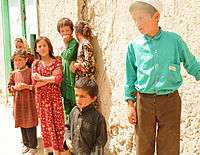 |
27% | 25–26.3% (of this 1% are Qizilbash) |
| Hazara |  |
9% | 6–13 percent |
| Uzbek |  |
9% | 6–8% percent |
| Aimak | 4% | 500,000 to 800,000 | |
| Turkmen | 3% | 2.5 percent | |
| Baloch | 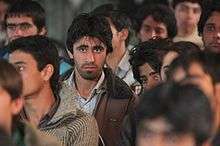 |
2% | 100,000 |
| Others (Pashai, Nuristani, Arab, Brahui, Pamiri, Gujjar, etc.) |  |
4% | 6.9 percent |
The 2004–present suggested figures in the above chart are supported by recent national opinion polls, which were aimed at knowing how a group of about 804 to 7,760 local residents in Afghanistan felt about the current war, political situation, as well as the economic and social issues affecting their daily lives. Seven of the surveys were conducted between 2004 and 2012 by the Asia Foundation and one between 2004 and 2009 by a combined effort of the broadcasting companies NBC News, BBC, and ARD.[35][36]
| Ethnic group | "Afghanistan: Where Things Stand" (2004–2009)[36] | "A survey of the Afghan people" (2006)[35] | "A survey of the Afghan people" (2007)[35] | "A survey of the Afghan people" (2008)[35] | "A survey of the Afghan people" (2009)[35] | "A survey of the Afghan people" (2010)[35] | "A survey of the Afghan people" (2011)[35] | "A survey of the Afghan people" (2012)[35] |
|---|---|---|---|---|---|---|---|---|
| Pashtun | 38-46% | 40.9% | 40% | Not reported | Not reported | 42% | 41% | 40% |
| Tajik | 37-39% | 37.1% | 35% | " | " | 31% | 31% | 33% |
| Hazara | 6-13% | 9.2% | 10% | " | " | 10% | 11% | 11% |
| Uzbek | 5-7% | 9.2% | 8% | " | " | 9% | 9% | 9% |
| Aimak | 0-0% | 0.1% | 1% | " | " | 2% | 1% | 1% |
| Turkmen | 1-2% | 1.7% | 3% | " | " | 2% | 2% | 2% |
| Baloch | 1-3% | 0.5% | 1% | " | " | 1% | 1% | 1% |
| Others (Pashayi, Nuristani, Arab, etc.) | 0-4% | 1.4% | 2% | " | " | 3% | 3% | 5% |
| No opinion | 0-2% | 0% | 0% | " | " | 0% | 0% | 0% |
Languages

Pashto and Dari are both designated as the official languages of Afghanistan.[4] Dari (Afghan Persian) serves as the lingua franca in Kabul, Herat, Mazar-i-Sharif and other cities in northern and north-western Afghanistan. It is the language resorted to when people of different ethnic groups need to conduct business or otherwise communicate. Pashto is widely used in southern and eastern areas of the country where ethnic Pashtuns are the majority. The Afghan National Anthem is recited in Pashto. Uzbeki and Turkmeni are spoken in certain northern provinces, but mainly among the Uzbek and Turkmen tribes. Smaller number of Afghans are also fluent in Urdu, Balochi, Arabic and other languages. English is taught in schools and is gradually becoming popular among the younger generation.
An approximate distribution of languages spoken in the country is shown in the line chart below:
| Language | World Factbook / Library of Congress Country Studies (1992-present estimate)[1][12] | Ethnologue / World Factbook / Iranica (pre-1992 estimates)[32][38][39] |
|---|---|---|
| Dari (Afghan Persian) | 50% | 25-50% |
| Pashto | 35% | 50-55% |
| Uzbek | 8.5% | 9% |
| Turkmen | 2.5% | 500,000 speakers |
| 30 others (Balochi, Nuristani, Pashayi, Brahui, Hindko, Pamiri, Kyrgyz, Gujari, etc.) | 4% | 4% |
Based on information from the latest national opinion polls, up to 49% stated that they can speak or understand Pashto and up to 77% stated that they can speak or understand Dari. Uzbeki was spoken or understood by up to 11% and Turkmen by up to 7%. Other languages that can be spoken are Arabic (4%) and Balochi (2%)[35][36]
Religions

Almost the entire Afghan population is Muslim, with less than 1% being non-Muslim. Despite attempts to secularize Afghan society, Islamic practices pervade all aspects of life. Likewise, Islamic religious tradition and codes, together with traditional practices, provide the principal means of controlling personal conduct and settling legal disputes. Islam was used as the main basis for expressing opposition to the modernization of Afghanistan by King Amanullah in the 1920s. It was also used by the mujahideen during the 1980s Soviet war in Afghanistan and by the Taliban today.
- Islam: 99.7% of the total population
- Sunni Muslim: 80-90%[1][11][12]
- Shia Muslim: 7-19%[1][11][12]
- Other: less than 1%
- Sikhism: In the thousands
- Hinduism: In the thousands
- Zoroastrianism: Unknown/unreported
- Christianity: Unknown
- Judaism (one known individual: Zablon Simintov)
- Buddhism: Unknown
| Religion | "A survey of the Afghan people" (2004)[35] | "A survey of the Afghan people" (2006)[35] | "A survey of the Afghan people" (2007)[35] | "A survey of the Afghan people" (2008)[35] | "A survey of the Afghan people" (2009)[35] | "A survey of the Afghan people" (2010)[35] | "A survey of the Afghan people" (2011)[35] | "A survey of the Afghan people" (2012)[35] |
|---|---|---|---|---|---|---|---|---|
| Sunni Islam | 92% | 87.9% | 87% | " | " | " | " | " |
| Shia Islam | 7% | 10.4% | 12% | " | " | " | " | " |
| Ismailism– | 1% | 1.2% | 0% | " | " | " | " | " |
| Hinduism | 0% | 0.1% | 0% | " | " | " | " | " |
| Buddhism | 0% | 0.1% | 0% | " | " | " | " | " |
| Sikhism | 0% | 0.1% | 0% | " | " | " | " | " |
See also
References
- 1 2 3 4 5 6 7 8 9 10 11 "Afghanistan". The World Factbook. CIA. Retrieved 5 September 2015.
- 1 2 "Life expectancy in Afghanistan rises past 60 years". Pajhwok Afghan News. November 30, 2011. Retrieved December 5, 2011.
- ↑ UNESCO, Country profile, http://www.uis.unesco.org/DataCentre/Pages/country-profile.aspx?code=AFG®ioncode=40535
- 1 2 3 "Article Sixteen of the Constitution of Afghanistan". 2004. Retrieved July 25, 2012.
From among the languages of Pashto, Dari, Uzbeki, Turkmani, Baluchi, Pashai, Nuristani, Pamiri (alsana), Arab and other languages spoken in the country, Pashto and Dari are the official languages of the state.
- 1 2 3 Mohammad Jawad Sharifzada, ed. (November 20, 2011). "Afghanistan's population reaches 26m". Pajhwok Afghan News. Retrieved December 5, 2011.
- ↑ http://www.nybooks.com/articles/2016/04/21/what-chance-for-afghanistan/
- ↑ UNESCO, Country profile, http://www.uis.unesco.org/DataCentre/Pages/country-profile.aspx?code=AFG®ioncode=40535
- ↑ UNESCO, Country profile, http://www.uis.unesco.org/DataCentre/Pages/country-profile.aspx?code=AFG®ioncode=40535
- ↑ UNESCO, Country profile, http://www.uis.unesco.org/DataCentre/Pages/country-profile.aspx?code=AFG®ioncode=40535
- ↑ Ethnic map of Afghanistan, http://gulf2000.columbia.edu/images/maps/Afghanistan_Ethnic_lg.png
- 1 2 3 "Chapter 1: Religious Affiliation". The World’s Muslims: Unity and Diversity. Pew Research Center's Religion & Public Life Project. August 9, 2012. Retrieved 4 September 2013.
- 1 2 3 4 5 "Country Profile: Afghanistan" (PDF). Library of Congress Country Studies on Afghanistan. Library of Congress. August 2008. Retrieved 2010-09-03.
- ↑ "United Nations and Afghanistan". UN News Centre. Retrieved 29 December 2013. Archived October 31, 2013, at the Wayback Machine.
- ↑ "Chapter 2. The Society and Its Environment" (PDF). Afghanistan Country Study. Illinois Institute of Technology. pp. 105–06. Archived from the original (PDF) on 3 November 2001. Retrieved 12 October 2010.
- ↑ "Population". U.S. Library of Congress. 2008. Retrieved 2010-10-12.
- ↑ "Afghanistan (1979–2001)". Retrieved 2010-10-12.
- ↑ "Afghanistan – Population Reference Bureau". Population Reference Bureau. Retrieved 2009-12-29.
- ↑ "Estimated population of Afghanistan 2012-13". Central Statistics Office. Retrieved September 30, 2015.
- ↑ "United Nations and Afghanistan". UN News Centre. Retrieved 29 December 2013. Archived October 31, 2013, at the Wayback Machine.
- ↑ World Population Prospects: The 2010 Revision
- ↑ http://dhsprogram.com/pubs/pdf/FR248/FR248.pdf
- ↑ http://unstats.un.org/unsd/demographic/products/dyb/dyb2013.htm
- 1 2 3 "Afghanistan". World Health Organization (WHO). Retrieved 2013-07-06.
Life expectancy at birth m/f (years) 59/61
- ↑ "Health and Development" (PDF). World Health Organization (WHO). Retrieved December 12, 2011.
- ↑ Children at risk of contracting HIV/AIDS in Afghanistan. December 1, 2008.
- ↑ "Over 1,300 HIV cases registered in Afghanistan". Pajhwok Afghan News. December 1, 2012. Retrieved 2012-12-02.
- ↑ "AIDS patients have doubled in Kandahar: Official". Pajhwok Afghan News. December 2, 2012. Retrieved 2012-12-03.
- 1 2 "50pc surge in HIV cases, says Dalil". Pajhwok Afghan News. December 3, 2011. Retrieved 2011-12-05.
- ↑ http://www.pajhwok.com/en/2013/04/30/afghan-population-set-reach-275m-year
- ↑ Ghulam Hussain Zakiri, ed. (February 24, 2013). "14m Afghans to get computerised ID cards in a year". Pajhwok Afghan News. Retrieved 2013-05-04.
- ↑ Abasin Zaheer, ed. (May 26, 2013). "Senators stress caution in ID cards issuance". Pajhwok Afghan News. Retrieved 2013-05-04.
- 1 2 "The World Factbok – Afghanistan". The World Factbook/Central Intelligence Agency. University of Missouri. October 15, 1991. Retrieved 2011-03-20.
_#_Ethnic divisions: Pashtun 50%, Tajik 25%, Uzbek 9%, Hazara 12-15%; minor ethnic groups include Chahar Aimaks, Turkmen, Baloch, and other
- ↑ "Ethnic Groups". Library of Congress Country Studies. 1997. Retrieved 2010-10-08.
- ↑ "PEOPLE – Ethnic divisions:". The World Factbook/Central Intelligence Agency. University of Missouri. January 22, 1993. Retrieved 2011-03-20.
Pashtun 38%, Tajik 25%, Uzbek 6%, Hazara 19%; minor ethnic groups include Chahar Aimaks, Turkmen, Baloch, and others
- 1 2 3 4 5 6 7 8 9 10 11 12 13 14 15 16 17 See:
- "Afghanistan in 2012 – A survey of the Afghan people" (PDF). Kabul, Afghanistan: The Asia Foundation. pp. 181–182. Retrieved 2012-11-28.
Appendix 1: Target Demographics 181... Pashtun 40%, Tajik 33%, Uzbek 9%, Hazara 11%, Turkmen 2%, Baloch 1%, Nuristani 1%, Aimak 1%, Arab 2%, Pashaye 1%, Sadat 1%
- "Afghanistan in 2011 – A survey of the Afghan people" (PDF). Kabul, Afghanistan: The Asia Foundation. p. 251. Retrieved 2012-11-13.
15. Appendix 3: Interview Questionnaire... D-10. Which ethnic group do you belong to? SINGLE RESPONSE ONLY Pashtun 41%, Tajik 32%, Uzbek 9%, Hazara 11%, Turkmen 2%, Baloch 1%, Nuristani 1%, Aimak 1%, Arab 1%, Sadat 1%
- "Afghanistan in 2010 – A survey of the Afghan people" (PDF). Kabul, Afghanistan: The Asia Foundation. 2010. pp. 225–226. Retrieved 2011-03-20.
D-9. Which ethnic group do you belong to? SINGLE RESPONSE ONLY Pashtun 42%, Tajik 31%, Uzbek 9%, Hazara 10%, Turkmen 2%, Baloch 1%, Nuristani 1%, Aimak 2%, Arab 2%
- "Afghanistan in 2009: A Survey of the Afghan People" (PDF). Kabul, Afghanistan: The Asia Foundation. Retrieved 2012-11-28.
The 2009 survey interviewed 6,406 Afghans (53% men and 47% women)
- "Afghanistan in 2010 – A survey of the Afghan people" (PDF). Kabul, Afghanistan: The Asia Foundation. Retrieved 2012-11-28.
The 2008 survey interviewed 6,593 Afghans...
- "Afghanistan in 2007 – A survey of the Afghan people" (PDF). Kabul, Afghanistan: The Asia Foundation. 2010. pp. 225–226. Retrieved 2011-03-20.
The 2007 survey interviewed 6,406 Afghans, Which ethnic group do you belong to? SINGLE RESPONSE ONLY Pashtun 40%, Tajik 35%, Uzbek 8%, Hazara 10%, Turkmen 3%, Baloch 1%, Nuristani 1%, Aimak 1%, Arab 1%
- "Afghanistan in 2006 – A survey of the Afghan people" (PDF). Kabul, Afghanistan: The Asia Foundation. pp. 83–88. Retrieved 2012-11-28.
A total of 6,226 respondents were surveyed in the study, out of which 4888 (78.5%) were from the rural areas and 1338 (22%) were from the urban areas. Ethnicity: Pashtun 40.9, Tajik 37.1, Uzbek 9.2, Hazara 9.2, Turkmen 1.7, Baloch 0.5, Nuristani 0.4, Aimak 0.1, Arab 0.7, Pashayi 0.3
- "Afghanistan in 2004 – A survey of the Afghan people" (PDF). Kabul, Afghanistan: The Asia Foundation. 2004. Retrieved 2012-11-28.
The 2004 survey interviewed 804 Afghans, Which ethnic group do you belong to? Pashtun 46%, Tajik 39%, Uzbek 6%, Hazara 6%, Turkmen 1%, Baloch 0%, Nuristani 1%, Aimak 0%, Arab 1%, Pashaye 0%, Other 1%.
- "Afghanistan in 2012 – A survey of the Afghan people" (PDF). Kabul, Afghanistan: The Asia Foundation. pp. 181–182. Retrieved 2012-11-28.
- 1 2 3 "ABC NEWS/BBC/ARD poll - Afghanistan: Where Things Stand" (PDF). Kabul, Afghanistan: ABC News. pp. 38–40. Retrieved 2010-10-29.
- 1 2 "South Asia ::AFGHANISTAN". CIA The World Factbook.
- ↑ "AFGHANISTAN v. Languages". Ch. M. Kieffer. Encyclopædia Iranica. Retrieved 2010-10-10.
A. Official languages. Paṧtō (1) is the native tongue of 50 to 55 percent of Afghans... Persian (2) is the language most spoken in Afghanistan. The native tongue of twenty five percent of the population, it is split into numerous dialects.
- ↑ "Languages of Afghanistan". SIL International. Ethnologue: Languages of the World. Retrieved 2010-09-18.
Further reading
- Banting, Erinn. Afghanistan the People. Crabtree Publishing Company, 2003. ISBN 0-7787-9336-2.
- Caroe, Olaf (1958). The Pathans: 500 B.C.-A.D. 1957. Oxford in Asia Historical Reprints. Oxford University Press, 1983. ISBN 0-19-577221-0.
- Dupree, Nancy Hatch. An Historical Guide to Afghanistan. 2nd Edition. Revised and Enlarged. Afghan Air Authority, Afghan Tourist Organization, 1977.
- Elphinstone, Mountstuart. 1819. An account of the kingdom of Caubul, and its dependencies in Persia, Tartary, and India: Comprising a view of the Afghaun nation, and a history of the Dooraunee monarchy. Printed for Longman, Hurst, Rees, Orme, and Brown, and J. Murry, 1819.
- Habibi, Abdul Hai. 2003. "Afghanistan: An Abridged History." Fenestra Books. ISBN 1-58736-169-8.
- Hopkins, B. D. 2008. The Making of Modern Afghanistan. Palgrave Macmillan, 2008. ISBN 0-230-55421-0.
- Reddy, L. R. Inside Afghanistan: end of the Taliban era?. APH Publishing, 2002. ISBN 81-7648-319-2.
- Amy Romano. A Historical Atlas of Afghanistan. The Rosen Publishing Group, 2003. ISBN 0-8239-3863-8.
- Vogelsang, Willem. The Afghans. Wiley-Blackwell, 2002. Oxford, UK & Massachusette, USA. ISBN 0-631-19841-5.
External links
| Wikimedia Commons has media related to People of Afghanistan. |
- USAID/Afghanistan Strategy
- Afghanistan Information Management Services
- Central Statistics Organization of Afghanistan
- Ministry of Rural Rehabilitation & Development of Afghanistan
- Afghanistan – Naval Postgraduate School

